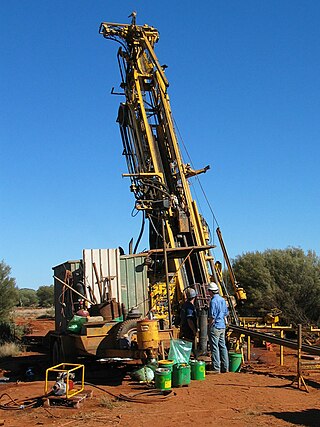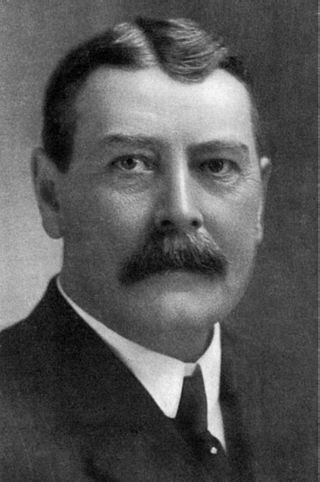
Mining is the extraction of valuable geological materials and minerals from the surface of the Earth. Mining is required to obtain most materials that cannot be grown through agricultural processes, or feasibly created artificially in a laboratory or factory. Ores recovered by mining include metals, coal, oil shale, gemstones, limestone, chalk, dimension stone, rock salt, potash, gravel, and clay. The ore must be a rock or mineral that contains valuable constituent, can be extracted or mined and sold for profit. Mining in a wider sense includes extraction of any non-renewable resource such as petroleum, natural gas, or even water.
Dresser Industries was a multinational corporation headquartered in Dallas, Texas, United States, which provided a wide range of technology, products, and services used for developing energy and natural resources. In 1998, Dresser merged with its main rival Halliburton. Halliburton sold many of former Dresser non "oil patch" divisions, retaining the M W Kellogg Engineering and Construction Company and the Dresser oil-patch products and services that complemented Halliburton's energy and natural resource businesses. In 2001 Halliburton sold five separate, but somewhat related former Dresser non "oil patch" divisions, to an investment banking firm. Those five operations later took the name "Dresser Inc." In October 2010, Dresser Inc., was acquired by General Electric. It is headquartered in Addison, Texas.

Baker Hughes Company is an American energy company based in Houston, Texas. As one of the world's largest oil field services companies, it provides products and services for oil well drilling, formation evaluation, completion, production, and reservoir consulting. It operates in over 120 countries, with research and manufacturing facilities in Australia, Singapore, Malaysia, India, Dubai, Saudi Arabia, Italy, Germany, Norway, Oklahoma, Louisiana and Missouri. From 2017 to 2020, the company was majority owned by General Electric (GE); however, GE no longer owns an economic stake in the company. The company is incorporated in Delaware.
Anglo American plc is a British multinational mining company with headquarters in London, England. It is the world's largest producer of platinum, with around 40% of world output, as well as being a major producer of diamonds, copper, nickel, iron ore, polyhalite and steelmaking coal. The company has operations in Africa, Asia, Australia, Europe, North America and South America.

A modern core drill is a drill specifically designed to remove a cylinder of material, much like a hole saw. The material left inside the drill bit is referred to as the core.
Element Six is a company specialised in providing synthetic diamond, cubic boron nitride and other superhard materials for industrial use. Part of the De Beers Group, Element Six employs over 1,900 people and its primary manufacturing sites are located in the UK, Ireland, Germany, South Africa, and the US.

Joseph Isaac "Diamond Joe" Gutnick is an Australian businessman, mining industry entrepreneur and the former president of the Melbourne Football Club (1996-2001). He is also an ordained Orthodox rabbi, and is well known for his philanthropy in the Jewish world. He declared bankruptcy in July 2016.

Exploration diamond drilling is used in the mining industry to probe the contents of known ore deposits and potential sites. By withdrawing a small diameter core of rock from the orebody, geologists can analyze the core by chemical assay and conduct petrologic, structural, and mineralogical studies of the rock. It is also often used in the geotechnical engineering industry for foundation testing in conjunction with soil sampling methods. The technique is named for the diamond encrusted drill bit used.

The National Mining Hall of Fame is a museum located in Leadville, Colorado, United States, dedicated to commemorating the work of miners and people who work with natural resources. The museum also participates in efforts to inform the public about the mining industry.
Adastra Minerals Inc, was a London-based mining company with notable operations in central Africa, particularly in copper, cobalt and zinc exploration. Adastra's properties and concessions were acquired in 2006 by First Quantum Minerals for $245m in cash and stock, outpacing a counter-offer by Mwana Africa plc. Founder Jean-Raymond Boulle and top UK insurer Prudential plc had owned 10% and 14% stakes in Adastra, respectively. In the mid-1990s, the company became known for developing highly prospective copper and cobalt mines in Zaire during a civil war.
Paladin Energy Ltd is a Western Australian based uranium production company.
Nabors Industries Limited is an American global oil and gas drilling contractor that has operated since 1972. Based in Houston, Texas, Nabors owns the largest land drilling fleet in the world with approximately 400 rigs in more than 20 countries. The company consists of the following business segments: U.S. Drilling, Canada Drilling, International Drilling, Drilling Solutions, and Rig Technologies. Nabors is notable for its historic association with the Guggenheim family.

The Mining industry of Ghana accounts for 5% of the country's GDP and minerals make up 37% of total exports. Gold contributes over 90% of the total mineral exports. Thus, the main focus of Ghana's mining and minerals development industry remains focused on gold. Ghana is Africa's largest gold producer, producing 80.5 t in 2008. Ghana is also a major producer of bauxite, manganese and diamonds. Ghana has 20 large-scale mining companies producing gold, diamonds, bauxite and manganese; over 300 registered small scale mining groups; and 90 mine support service companies. Other mineral commodities produced in the country are natural gas, petroleum, salt, and silver.
In 2006, Cambodia's mineral resources remained, to a large extent, unexplored. Between 2003 and 2006, however, foreign investors from Australia, China, South Korea, Thailand, and the United States began to express their interest in Cambodia's potential for offshore oil and gas as well as such land-based metallic minerals as bauxite, copper, gold, and iron ore, and such industrial minerals as gemstones and limestone.
The Buena Vista Mine is located 21 miles (34 km) southeast of Lovelock, Nevada. In the past, the area has been known as the Mineral Basin, though another name for the area has been the Buena Vista District. There are at least two other Buena Vista Mining Districts in Nevada; one is located near Unionville, Nevada, and the other is located in Esmeralda and Mineral counties near the California border. The nearby Buena Vista Hills are named for the mine. The district encompasses roughly 21 square miles (54 km2) of mineral and surface rights, and is one of the largest un-mined iron ore resources in the western United States.

Joy Global Inc. was a company that manufactured and serviced heavy equipment used in the extraction and haulage of coal and minerals in both underground and surface mining. The company had manufacturing facilities in Alabama, Pennsylvania, Texas, Wisconsin, Australia, Canada, China, France, South Africa, Poland and the United Kingdom. In 2017, Joy Global was acquired by Komatsu Limited and was renamed Komatsu Mining Corp.
Svenska Bergsbruk AB, formerly Wiking Mineral AB, was a junior mineral exploration and mine development company. The firm was founded in 2005, and primarily engaged in mine development and active exploration for base and precious metal deposits in Sweden.
Anglovaal Group was one of six large South African holding conglomerates that had interests in mining, finance and industry. It was formed in 1933 as the Anglo-Transvaal Consolidated Investment Company Limited with interests initially in mining. In 1981, it became Anglovaal Limited. It was majority owned throughout its existence by the Hersov and Menell families. In the late 1990s, it would form into two separate companies, Anglovaal Industrial Holdings (AVI) and Anglovaal Minerals (Avmin). As a family owned business, all family interests were to be diluted by 2001. By 2003, Anglovaal Minerals became part of African Rainbow Minerals Limited, a listed black empowerment company.
Stonewall Resources is an Australian gold mining company with exploration and development operations in New South Wales, Australia and Mpumalanga Province, South Africa.

The Longyear Drill Site is a historic mineral exploration site in Hoyt Lakes, Minnesota, United States. In 1890 the first core samples were taken there from what would become known as the Mesabi Range, one of the world's richest iron ore deposits. The exploration diamond drilling process was led by Edmund J. Longyear, who went on to drill 7,100 test pits all across the Mesabi Range. In 1976 the Iron Range Historical Society developed the site as a historic attraction with period drilling equipment. It is now managed by the city of Hoyt Lakes in partnership with the Hoyt Lakes Garden Club.










